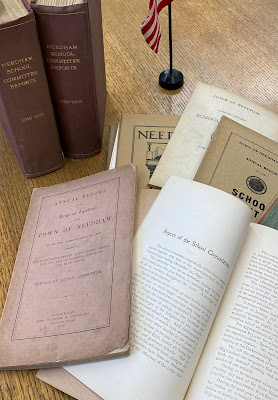The ongoing renovation of the Needham Public Schools Administration and Operations Building, named after 19th Century School Committee member Emery Grover, has provided an opportunity to reflect both on the past and the present.
In preparation for our move to temporary quarters and while sifting through the “EG Building” attic and long forgotten closets and store rooms, I discovered a trove of historic and academic information and documents that chronicle the story of the Needham Public Schools from the 1800s to the present.
 |
| Early 20th and 19th Century School Committee Reports |
One of the biggest changes (and challenges) has been the incredible growth of the community over the years. For example, in 1923 School Superintendent John Davis reported that the total enrollment of 1,800 pupils that year exceeded the capacity of available classroom space. One hundred years later we now enroll over 5,500 students, and we are still short on classroom space!
We have also grown more racially and culturally diverse. In the last 20 years the Needham Public Schools has gone from enrolling a 90% white student body to enrolling about 73.0% white students with 27.0% representing students of color. In addition, the percentage of students for whom English is a second language has increased from about 4.0% to over 11.0% of total student enrollment. Today, over 51 languages are spoken by our students and families, including Spanish, Chinese, Ukrainian, Russian, Arabic, Hebrew, Korean, and Azerbaijani among many others. In the same period of time the number of low income students has tripled from 2.7% to 8.2% of overall enrollment.
Our families and student body look different today than they did a century or even a generation ago, and this diversity has strengthened the community, schools, and learning experience for all of our students. (Click here for more information about demographic trends in the Needham Public Schools.)
What hasn’t changed is the Needham community’s strong commitment to a quality education for every child.
Since before the Civil War, the Needham community recognized its responsibility for providing a rigorous and excellent educational experience for all students. In its 1859 report to the community, the Needham School Committee praised parents and families for their engagement: “The purpose of a school depends very much upon the interest taken in it by the parents. In many of our schools the parents have long since taken a deep and active interest in their children’s progress and welfare.”
The same 1859 report revealed that providing adequate compensation for teachers must remain a priority for the community: “Though some think we are now paying our teachers too much, we are constantly losing the services of the best of them, because they can obtain better pay elsewhere… The only alternative seems to be, either to increase the teachers’ pay a little, or to retard the present healthy progress of our students and schools…”
What’s really striking about this mid 19th Century report is how, even then, the community recognized the critical need to develop the social and emotional skills of children: “The moral character of a school is of vital importance; mental cultivation at the expense of the cultivation of the heart, is a curse rather than a blessing. Not the more knowing & the more scientific, but rather the more virtuous the child, the man, and the people - the more happy and more useful.”
Today, 164 years later, those very sentiments are echoed in the district’s current Portrait of a Needham Graduate competencies and strategic priorities which we continue to believe are critical to the growth and success of students.
 |
| Cover of the 1861-62 Report from the Needham School Committee and Superintendent |
For sure, a lot has changed in Needham over the years, and we have become a stronger and more diverse community of learners and leaders. And a lot has remained the same.
This wise community believed then - and continues to believe today - that “the cultivation of the heart” is essential to our students’ potential and academic growth as well as the collective success and wellbeing of a vibrant, prosperous, and caring community.